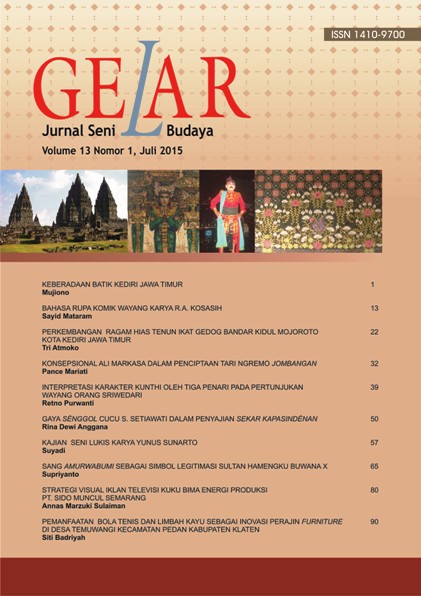KEBERADAAN BATIK KEDIRI JAWA TIMUR
Main Article Content
Abstract
The article entitled “Keberadaan Batik Kediri Jawa Timur†(The Existence of Batik Kediri East Java) coversthe appearance and the development of batik in Kediri Residence. The analysis result uses qualitativemethod. Theories concerning culture and history are used to solve problems of the existence and characteristicsof batik Kediri in relation to the presence and the activities of batik making in Kediri through the culturalapproach, aesthetic approach by AAM, and Djelantik is applied to analyze the forms of batik Kediri motives.Analysis process is executed in two steps covering interactive and interpretative developed by Miles andHuberman. The characteristics of batik Kediri can be reviewed from the shape and the structure of batik withthe technique of natural and synthetic coloring. The values contained in batik Kediri show the condition ofKediri area. It can be seen from the several forms of batik pattern and motive made by batik maker in Kediri.The aesthetics of batik Kediri can be seen and felt from the pattern of tourism and local culture, abstractpattern, the creative pattern of natural suggestion, classic pattern, and the unity of classic pattern andnatural suggestion.
Keywords: batik, aesthetics, motive, Kediri
Downloads
Article Details
Copyright
Authors who publish with Gelar: Jurnal Seni Budaya agrees to the following terms:
- Authors retain copyright and grant the journal right of first publication with the work simultaneously licensed under a Creative Commons Attribution License (CC BY-SA 4.0) that allows others to share the work with an acknowledgment of the work's authorship and initial publication in this journal.
- Authors are able to enter into separate, additional contractual arrangements for the non-exclusive distribution of the journal's published version of the work (e.g., post it to an institutional repository or publish it in a book), with an acknowledgment of its initial publication in this journal.
- Authors are permitted and encouraged to post their work online (e.g., in institutional repositories or on their website) prior to and during the submission process, as it can lead to productive exchanges, as well as earlier and greater citation of published work.
